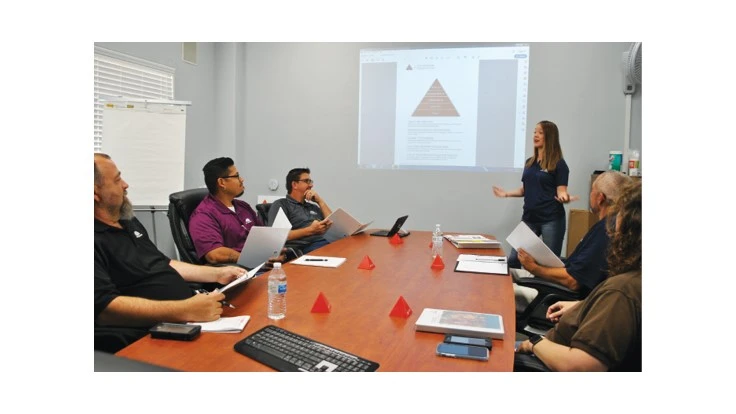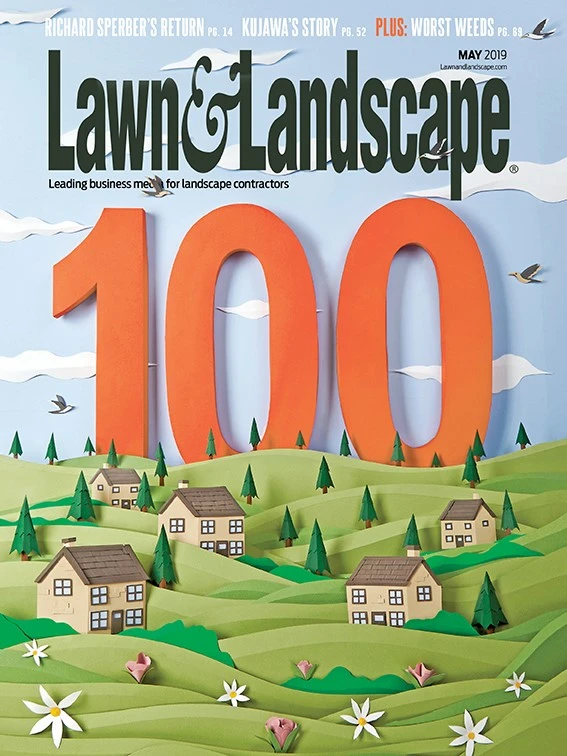

Silos tend to form as companies grow. You’ve got your office and field silos. Then, there are operations and sales silos. There are silos of executive leadership, department managers and field supervisors. Field labor has a silo of its own, too.
“We have been really fortunate in our 30 years of business that we have gained so many talented people, but we were seeing situations where maybe people weren’t necessarily confronting each other to solve issues,” says Rebecca Herro, the chief development officer of DLC Resources in Phoenix, Arizona.
Rather than having direct conversations, creating “work arounds” can be more comfortable. For example, if Joe doesn’t complete his part of a project, his teammate Tom goes straight to the boss rather than talking to Joe about it. Or, maybe emails are sent back and forth rather than teammates having face-to-face conversations.

At DLC Resources, which ranked 86 on the Top 100 list with $24.9 million in 2018 revenue, a desire to foster employee engagement resulted in forming a leadership development initiative that combines two programs: Everything DiSC, a personal development experience; and The Five Behaviors of a Cohesive Team, based on New York Times bestseller Patrick Lencioni’s work.
So far, the entire leadership team, including operations, department and field managers, have completed the six-month program, which involves meeting every three weeks and “homework” between sessions. Now the company is rolling out an adapted version for its crew foremen.
“We are seeing better conversations and an improved ability to provide helpful feedback,” Herro says. In fact, they have no choice but to chime in because a key component of the program is commitment to sharing. “Along with that is the idea that everyone has to weigh in at meetings, even if they don’t get their way,” Herro says. “If you are in the room, you have to participate. You are not allowed to say, ‘I don’t have anything to say.’ You have to engage.”
Designing a leadership program.
Buy-in from the top is critical when developing a leadership development program, Herro says.
“We are an employee-owned company, so employees naturally are more engaged in the business,” Herro says. “Our profitability is what drives the (Employee Stock Ownership Plan) value, and everyone’s ability to build wealth. So, with this substantial change in our company structure in the last 10 years, our employees are now working toward their own retirement plans, and that brings a different perspective.”
Specifically, employees are motivated to make decisions that save cost, improve efficiency and drive profitability. They may bring up an idea to save time and labor, Herro says. The ESOP is a conversation starter.
“Employees might say, ‘I’ve been thinking about the ESOP,’ and it gives them an ‘in’ to have a conversation with their supervisor that they might not have had before,” Herro says.
“We are an employee-owned company, so employees naturally are more engaged in the business ... our employees are now working toward their own retirement plans, and that brings a different perspective.” Rebecca Herro, chief development officer, DLC Resources
The leadership development program continues and expands this momentum by reinforcing a culture of conversations and collaboration. Not to mention, the program is an investment in leaders and team members. In a challenging labor market, offering such development can give a company a competitive edge. “Our ability to hire, train and retain employees is probably the most important thing we do every day, so this is another way a program like this can help,” Herro says.
DLC Resources looked into different program options before creating its leadership development initiative. It selected its current program because of the focus on behavior and how different personalities interpret information and communicate with each other. “It’s interesting to hear employees share how they interpret a statement,” Herro says. “You assume that people think like you. You learn how people perceive information and the way they look at ideas, whether a person is naturally skeptical or naturally more accepting, or if they work at a fast or more moderate pace. Owning those characteristics and having the group acknowledge that can go so far.”
Herro says the personality profiles have been enlightening. “We’ve had people say, ‘I had no idea you felt like that!’”
Combining the two programs rounds out DLC Resources’ leadership development program by integrating the concepts of trust, productive conflict, commitment to decisions, accountability and achieving collective results. This is the teamwork and collaboration piece that helps tear down organizational silos.
For example, a team member brings an issue to the boss, who asks, “Did you talk to the person you have an issue with?” The employee says, “No, I’m bringing the issue to you.”
Herro says, “Since implementing the leadership development program, we are seeing much more collaboration and more conversations between co-workers. The most significant area of growth has been in a willingness to give feedback to the correct person.”

Cultivating collaboration.
Sure, there is some stalling that naturally occurs when launching a leadership program. There’s work to do – homework. Participants must do more than just show up and listen. They have to participate, and that can be uncomfortable at first.
“We built in homework where they had to test out the concepts we discussed in workshops, and the first couple of sessions, some people were coming unprepared and we had to call a timeout,” Herro says. “We had to say, ‘If we are serious about this initiative, we can’t let that happen. We need to dig in.’”
After that initial snag, managers recognized the work they did outside of the sessions was integral to helping them grow as leaders.
“It has been a neat process to lead, and interesting when you see people have those ‘aha moments’ where a light bulb comes on and they think, ‘I could try that,’” Herro says. “It empowers people to ask questions and recognize it’s not about their titles. They are members of a team and have a responsibility to ask questions and have tough conversations.”
Overall, team members involved in the program were striving to do better. They personally and professionally wanted to improve for the sake of driving the company forward. Because again, when the ESOP wins, everyone wins.
Now that senior leadership has participated in the program, Herro says the key is to continue the momentum.
“We brought in a consultant who helped us kick off the program and mentored us, and she has been instrumental in its success,” Herro says, recommending that companies wanting to roll out a leadership program seek a third-party pro to assist with facilitating the process and holding everyone accountable.
Herro says leadership development programs make meetings more difficult – and worth it – because everyone is willing to contribute.
“We got the groundwork for the program and how we wanted to frame it, then we talked about how we want the program to live – how we keep it going,” she says.
Further, Herro earned accreditation in both programs the company uses, basically becoming the in-house expert.
Her advice: “Get certified in the program you are going to deliver so you really know the content.”
Does leadership development make everything in business easier? Not exactly. Meetings are actually harder. “You’re getting it all out there,” Herro says.
But she says the results are far better. When implementing a direction or initiative, leaders are using more “we” than “they.”
“There is more ownership of decisions, and our meetings are definitely more energized,” Herro says. “And we are getting better outcomes because everyone is pulling in the same direction.”

Explore the May 2019 Issue
Check out more from this issue and find your next story to read.
Latest from Lawn & Landscape
- ExperiGreen, Turf Masters Brands merge
- EquipmentShare cuts ribbon on new Maryland branch
- Strathmore acquires Royal Tree Service in Montreal
- In a new direction
- The December issue is now live
- Ignite Attachments debuts 80-inch, severe-duty bucket
- EquipmentShare breaks ground on Roswell branch
- NaturaLawn of America adds Schwartz, Medd to operations team





